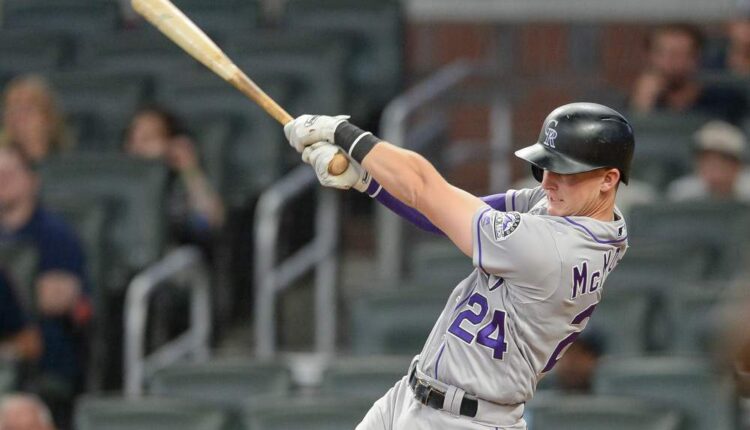As the draft season ramps up, it is always good to look over the average draft position (ADP) to find some perceived value. One of the best-perceived value forms is finding players with similar skill sets and likely statistical outcomes with ADPs that differ quite a bit. The value is waiting and drafting the second player at a cheaper ADP while using the early draft pick on a different team need.
When combing through the NFBC Draft Champions (DC) ADP, there are a lot of excellent values that relate to similar players. Over the following few articles, I will be digging into some of these values to help you better plan your draft strategy and maximize the best out of your teams as you leave the draft room.
The first ADP analysis, looking into similar players, will revolve around the hot corner. First, I will look into a free agent third baseman with outfield eligibility and compare this player to a younger third baseman with second base eligibility. The players being compared are Kris Bryant and Ryan McMahon, so let’s dig in and explain why passing on Bryant while waiting to draft McMahon is a smart draft decision.
The Curious Case of Kris Bryant
In recent years, Bryant has battled some injuries, but he has played in 144 or more games in five of six full seasons over his career. Over those five seasons, he has collected at least 586 plate appearances each season and has over 600 plate appearances in four of those seasons. The playing time consistency for Bryant is a plus for the veteran.
Bryant’s power production has been solid, hitting at least 25 home runs in the five seasons he played in at least 144 games. The home runs have been there for Bryant, but strangely enough, the run production has not been as he has not driven in over 77 runs in any of the last four seasons. That’s a whole lot of solo home runs or lack of run-producing hits outside of the long ball for the former MVP.
Looking deeper into Bryant’s statcast metrics, things are a bit concerning.
| Statcast | 2017 | 2018 | 2019 | 2020 | 2021 |
|---|---|---|---|---|---|
| Barrels | 8.90% | 8.40% | 8.80% | 5.50% | 10.30% |
| Hard-HIt | 37% | 33.30% | 33.80% | 31.90% | 39.70% |
Bryant’s barrel rates and hard-hit rates do not scream a significant home run hitter.
Since 2017, Bryant has had a hard-hit rate no better than 70 percentile. If we use the philosophy that roughly 60% of barrels are home runs (varies from year to year), Bryant has overachieved in home runs every season.
Bryant has perennially relied on a high BABIP that coincides with a line drive rate that usually ranges from 20-25%. The line drive rate helps with the high BABIP, allowing him to succeed with low barrels and a low hard-hit rate.
The 30-year-old Bryant has succeeded more often and underperformed his ADP many times. That could very well be the same this year, especially without knowing exactly where he will call home. So, for now, Bryant is a do not draft most of the time. I would rather wait till later in drafts and get someone with simile offensive upside.
The Case for Drafting McMahon
Ryan McMahon has shown a consistent floor over his first two full seasons (2019 and 2021). He hit 23 and 24 home runs, stole five and six bases, scored at least 70 runs, drove in at least 80 runs, and hit .250. McMahon was solid in his first two full seasons, which always appeared to have playing time concerns before the season started. However, those concerns were squashed as he played in 141 and 151 games and racked 539 and 596 plate appearances.
The base stats are solid, but McMahon has a lot to like when digging deeper. He has had an ISO over .195 each season, representing a nice average amount of extra bases McMahon achieves per at-bat. At the same time, he is also showing better plate discipline when he is not putting the ball in play. He is walking nearly 10% of the time each season while also improving his strikeout rate.
In 2019, McMahon struck out 29.7% of the time (34.2% of the time in the shortened 2020 season), then improved his strikeout rate to 24.7% in 2021. He does a solid job of limiting his O-Swing% to below-average while swinging more on pitches in the zone. McMahon’s contact rates across the board are below average, which likely leads to the continued strikeout rate from 25-30%. His contact gains from 2019 to 2021 were also enough to decrease his strikeout rate by nearly 5%.
Another significant change for McMahon was his increase in fly-ball rate while simultaneously cutting down his ground ball rate.
| Year | LD% | GB% | FB% |
|---|---|---|---|
| 2019 | 21.3% | 50.8% | 27.9% |
| 2020 | 15.0% | 50.5% | 34.6% |
| 2021 | 24.0% | 38.5% | 37.5% |
The massive drop in ground ball rate was amazing and translated to more line drives and a few fly balls for the most part. When looking at his statcast page, the increase in flyballs and line drives makes sense as his launch angle improves, which correlates to a solid barrel and hard-hit rate.
| Year | LA | Barrels | Hard-Hit |
|---|---|---|---|
| 2019 | 8.8 | 8.7% | 47.8% |
| 2020 | 9.2 | 11.2% | 43.0% |
| 2021 | 14.3 | 7.3% | 43.4% |
Now, this is fine and dandy and can get even better. The way it can get better would be pulling the ball more. McMahon spreads it all over the field and hits it to the opposite field more than pulling the ball.
| Year | Pull% | Cent% | Oppo% |
|---|---|---|---|
| 2019 | 33.9% | 38.2% | 28.0% |
| 2020 | 40.2% | 30.8% | 29.0% |
| 2021 | 30.6% | 36.8% | 32.6% |
McMahon’s batting average should stay around .250 or maybe better if he continues to spray the ball the way he does, especially with the spacious outfield in Coors Field. If we are looking for power, then we need more pulled power. That would be a fantastic start if he can return to the 2020 season. The good thing is McMahon is young, and there is plenty of time to continue to improve and become an even bigger power bat.
At worse, McMahon brings a solid floor to the third baseman position with plenty of room for upside. He is locked into regular playing time at third base for the Rockies, which is excellent as there were always platoon questions in previous seasons. A significant reason McMahon has multi-positional eligibility yet again.
Pass on Bryant and draft McMahon.
A lot of people love Bryant. Unfortunately, I am not one of them. Sure, he has had an MVP season, but he has also had many frustrating seasons since then. He has battled injuries that have limited his production, and now he is looking for a new team in 2022.
On the flip side, we have McMahon, who is locked into a third base role for the Rockies. As you all know, he will play half his games in Coors Field, which is fantasy gold. He is also 27-years-old and will be entering his fourth MLB season with everyday playing time.
When looking at projections, they are not the end all be all, but they tell a good story. Bryant and McMahon are projected for very similar offensive statistics.
| Bat X | AVG | HR | R | RBI | SB |
|---|---|---|---|---|---|
| Bryant | .261 | 23 | 80 | 74 | 6 |
| McMahon | .254 | 23 | 76 | 76 | 5 |
Bryant projects for a better batting average while everything else is relatively similar. The argument can be made that we have seen Bryant’s ceiling, and he can shatter these numbers, but we have not seen that in a while. McMahon’s stat line is a line he has produced in each of his last two seasons. He seems reliable while knowing he can continue improving and potentially outperforming his projections.
When digging in on these two third basemen, it is all about the draft day value that locks McMahon in for me over Bryant. Since January 15th, Bryant’s ADP is 101 (8th 3B), while McMahons ADP is 166 (14th 3B). In a 15-team league, that is a four-round value. So instead of drafting Bryant, you can draft pitchers like Alek Manoah or Shane McClanahan, a catcher like Daulton Varsho, or outfielders like Bryan Reynolds, Christian Yelich, or Cody Bellinger. All these players are around the same ADP.
If you do not like McMahon, you can draft similar projections at the third base later with Yoan Moncada, Josh Donaldson, or Jeimer Candelario (less power). Knowing the opportunity costs of certain players and the value that can be had later in drafts is the key to maximizing your drafts. Some will be a few rounds apart, while others will be many more. Drafting Ryan McMahon over Kris Bryant is one example of many opportunities to find some draft-day value.
Fantrax was one of the fastest-growing fantasy sites of the last few years, and we’re not stopping now. With multi-team trades, designated commissioner/league managers, and drag/drop easy click methods, Fantrax is sure to excite the serious fantasy sports fan – sign up now at Fantrax.com.


